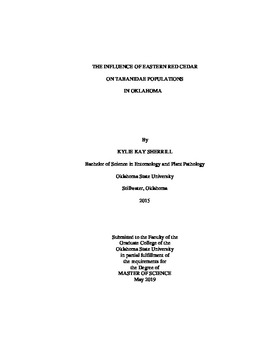| dc.contributor.advisor | Talley, Justin | |
| dc.contributor.author | Sherrill, Kylie Kay | |
| dc.date.accessioned | 2019-10-25T20:25:23Z | |
| dc.date.available | 2019-10-25T20:25:23Z | |
| dc.date.issued | 2019-05-01 | |
| dc.identifier.uri | https://hdl.handle.net/11244/321612 | |
| dc.description.abstract | Horse flies (Tabanidae) are commonly associated with pastured beef systems in the southern United States and are one of the most difficult fly pests to control. Tabanids are strong visual predators with a painful bite and can fly miles to find their hosts. Cattle are continually exposed to multiple species of tabanids throughout the summer, but little is known about the effect of landscapes and vegetation type on tabanid behavior. In the last few decades there has been an increase in Eastern Red Cedar (ERC), Juniperus virginiana, encroachment across Oklahoma. The majority of western Oklahoma is prairie, however, ERC is encroaching and altering the landscape. Biting fly populations as well as the diseases they transmit have been on the rise. The objectives of this study were to 1) determine habitat use by tabanidae in relation to ERC and 2) determine the abiotic factors that are associated with tabanidae use of ERC habitat. In 2017 and 2018 we employed two different styled traps into habitat classified by the percentage of ERC to monitor the Tabanus, Chrysops and Hybomitra in the area. Data was collected for 20 weeks and analyzed. The data was evaluated along with abiotic weather factors to study the effect on tabanid populations. Habitat association was significantly higher in Open Canopy Cedar habitat both years of the study, regardless of genus or trapping type. Abiotic factors influencing the abundance of tabanids varied by year, genus and species. This study provided support that tabanidae in Oklahoma are utilizing Open Canopy Cedar habitat and removing ERC from beef pastures could be a viable method to controlling tabanid populations. | |
| dc.format | application/pdf | |
| dc.language | en_US | |
| dc.rights | Copyright is held by the author who has granted the Oklahoma State University Library the non-exclusive right to share this material in its institutional repository. Contact Digital Library Services at lib-dls@okstate.edu or 405-744-9161 for the permission policy on the use, reproduction or distribution of this material. | |
| dc.title | Influence of Eastern Red Cedar on Tabanidae Populations in Oklahoma | |
| dc.contributor.committeeMember | Noden, Bruce | |
| dc.contributor.committeeMember | Goodman, Laura | |
| osu.filename | Sherrill_okstate_0664M_16279.pdf | |
| osu.accesstype | Open Access | |
| dc.type.genre | Thesis | |
| dc.type.material | Text | |
| dc.subject.keywords | deer fly | |
| dc.subject.keywords | eastern red cedar | |
| dc.subject.keywords | horse fly | |
| dc.subject.keywords | oklahoma | |
| dc.subject.keywords | tabanidae | |
| thesis.degree.discipline | Entomology and Plant Pathology | |
| thesis.degree.grantor | Oklahoma State University | |
